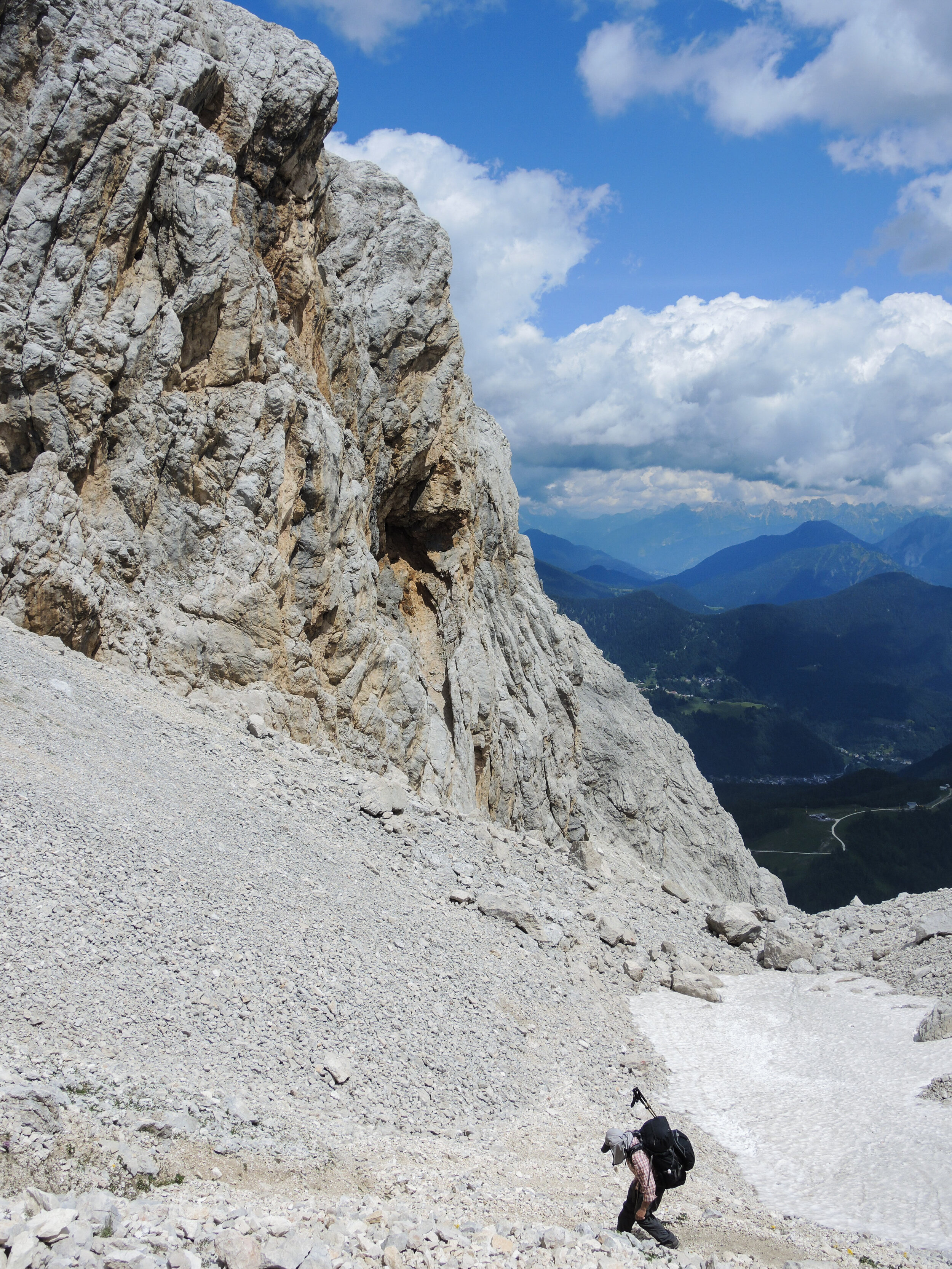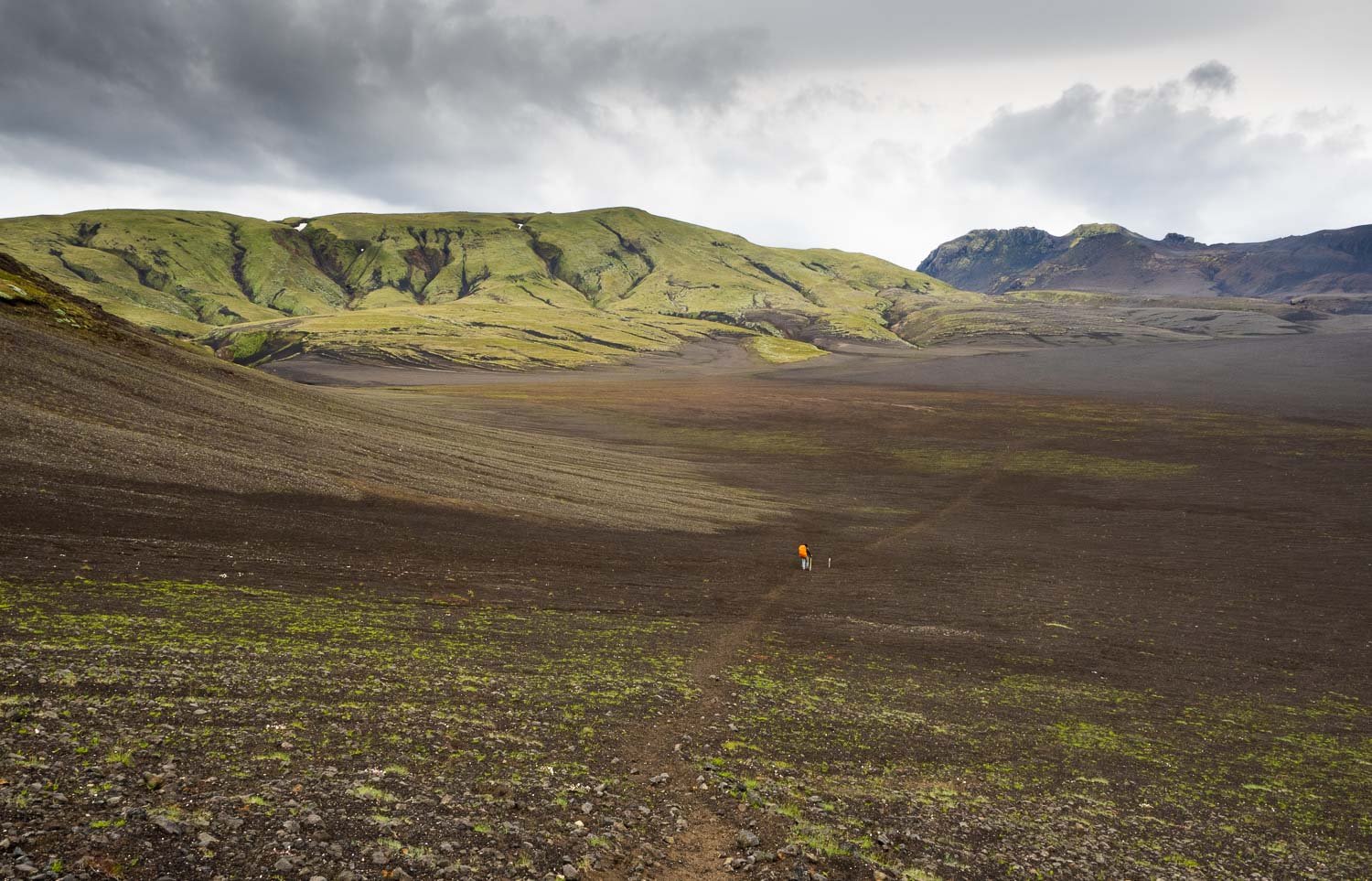Seven Reasons to Reduce Your Pack Weight
You may have read about "Ultralight Hiking" and “Gram Weenies”, hikers who cut their toothbrush in half, tags out of clothing, and sleep under a tarp on a sheet of plastic. You’re pretty sure that’s not for you. If it is, well good on you and go for it!
But, “I’d much rather carry a heavy pack than a light one,” … said no one ever.
The views were great but it was harder than necessary to get to see them
One extra kilo means nothing when you easily carry twenty, but only have ten in your pack. You may not even notice the difference between ten and eleven kilos. But if you are close to your limit at twenty, you will definitely notice twenty-one kilos. Two days into a four day hike, our strong, strapping 186cm/6ft1in friend was wilting under the weight of his very heavy pack. He ditched 1.5 L of his water and was astonished by what a difference it made. All kilos are not the same when you are carrying them!
You needn’t go to extremes but, if you haven’t upgraded your pack, mat and 3kg two person tent in the last 10-15 years, consider the fantastic new ultralight materials and equipment available now; even budget knockoffs can be good quality. Not only gram weenies benefit from a lighter pack: the principles of ultralight hiking can be used across a spectrum of hiking styles – and, ironically, weights – to enhance your time on the track. For people who hike in pairs, the weight savings and benefits are even bigger.
1. Reduce Injuries and Wear and Tear on the Body
Geoff and I hiked the Dolomites and the Tour Mont Blanc when we were about fifty. The TMB was a spectacular and surprisingly demanding eleven days (one rest day). The demanding part was a daily elevation gain and loss between 900m-1200m/2950-3940ft: big climbs for a couple of South Australians! We usually hiked up each morning, had lunch at elevation, then hiked down to accommodation in a valley.
Near the top …. must be lunch time!
We carried sleeping bag liners, clothes and toiletries, but no sleeping bags, kitchen or tent. Little food, either: breakfasts and dinners were in huts or in villages. But I was carrying way too much, of the wrong things. Too many clothes. Too many toiletries. Plus a bombproof canvas pack with detachable daypack that weighed 3.4 kg/7.5lbs… empty. My full pack weight was about 14kg/31lbs, Geoff’s closer to 20kg/44lbs without tent, food or kitchen! Heaven knows what those weights might have been with those things plus food added… 22kg/49lbs? 30kg/60lbs?
We all expect feet, joints and backs to creak and tire on hikes, especially as we age. And we embrace the suck because Plan B is not walking at all! But the last few hours of every day on the TMB were, I admit, rather a death march. Geoff’s knees swelled ominously, and more, sooner, on each descent. My feet didn’t just ache: the pain was severe enough to crush a lot of enjoyment, and it arrived earlier each afternoon, with tendonitis undiagnosed until much later.
We enjoy doing many things together, but really… matching knee braces?
We’d managed similar weights before, but this was the first time we both experienced injuries because of what we carried. Injuries from falling or tripping are also more likely to happen, and more likely to cause injury, when you are carrying a heavier pack. I was certain it was our last multiday independent hike.
Scrambling the scree slopes in the Dolomites was fun but also put added pressure on joints, with unexpected slips made worse with extra weight on board - oh my aching knees!
At home, glumly browsing hiking websites looking at all the walks we probably wouldn’t do, I stumbled across "Ultralight Hiking". What an epiphany!
With research, and time to save up, we eventually bought new packs, tent, raingear, sleep system and kitchen. Added together, all this gear weighed almost 2.5kg LESS than our previous two EMPTY canvas packs! And an astonishing 4.5kg/9.9lbs less than our two original packs and original goretex rain gear! Lighter weights for two are easily doable.
Geoff's Osprey Exos pack (below) still looks bulky with eleven days’ worth of home dehydrated food between us, but his summer base weight (weight without fuel, water and food) is under 9kg/20lbs and mine is about 7kg/15lbs – certainly not ultralight, but a far cry from where we were. And now, he has a pack that shaves an extra 600g/1.3lbs from the Exos, the 70L ArcHaul Ultra, which weighs just 600g/1.3lbs empty. Just extraordinary! When you hike with a companion, it means those pack weights can stay low even on extended journeys. For more information on HOW to lighten your pack, see here.
With a lighter pack weight I could focus on the views rather than reaching camp!
Best of all, there have been no more injuries from the weight we are carrying. A comfortable carry that doesn’t cause me foot problems is 11-12kg/24-26lbs pack weight (pack weight is base weight of non-consumables PLUS consumables of fuel, water and food). Geoff’s is about 17kg/37.5lbs. For shorter multiday hikes, we each carry well under these weights, at around 9kg/20lbs and 14kg/31lbs. Many hikers carry even less, but we like our comforts!
For multiday trips, your comfortable carrying weight is one that no one else can tell you. If you are young and strong with nicely oiled joints, double my pack weight could be fine for you. If you have foot, knee, hip, back or other health problems, you might need a lower pack weight than mine. Fortunately, when there are two of you, you have far more opportunities to drop pack weight, and drop it further, than can solo hikers.
2. Hike further, faster
For those of you whose pack weight isn’t a bother and doesn’t tire you, there is no need to change a thing in your gear list, whatever weight you carry. Ignore those who say you should go lighter – you’re comfortable, your pack is no impediment.
For others, at first glance hiking further, faster might seem irrelevant if you walk to experience the landscape: it’s not a race and the journey is more important than the destination. But consider more carefully, and you’ll notice how many options a lighter pack opens up. Rather than pushing yourself, you’re removing an impediment that slows you down and possibly detracts from your enjoyment. When your natural hiking pace is faster, you’ll not only cover more ground, but you’ll be less fatigued and be able to appreciate more of your surrounds, especially on multiday hikes.
Hikes that were previously dismissed because distances between campsites were too great, will suddenly be within reach. Hikes with more elevation gain that you previously thought manageable because you climb too slowly to summit and descend in the allotted timeframe, will now be an option. You’ll be less fatigued, and will be able to hike more days without a rest day.
A rare 30km/18.6mi day in Iceland to reach a safe camp site with bad weather approaching — a long day for us but doable with lighter packs.
3. Hike More Days
With lighter packs and less weight and space inside them taken up by tent, sleeping gear and kitchen, you can carry more food. Geoff’s upper limit is around 18kg/39.7lbs. If he had a base weight of 14kg/31lbs, this would only leave 4kg/8.8lbs for food, fuel and water, or just a few days’ supply. But with a base weight of 9 kg/20lbs, that leaves 9kg/20lbs for consumables.
As well, because this weight includes food and fuel, packs get lighter each day– it’s not like base weight that is the same on Day 1 as it is on Day 11. With our lightweight but far from ultralight base weights of 7kg/15lbs and 9kg/20lbs, Geoff and I can hike for 11 days with winter gear and daily water sources. This would have been inconceivable to us even seven years ago. We haven’t yet explored our limit with summer gear but it should be several days more. If you hike 20km/12mi a day as a couple, your range could easily be 220km/137mi+ without resupply as long as water is available.
Appreciating the wild sky on Day 11 of our Walls of Jerusalem Hike
Have you hesitated in attempting a multiday hike because you don’t think you can carry all your gear plus food? If you have, then a lighter pack is worth considering.
4. Improve Flexibility
When you and your hiking partner both have spare capacity, it allows for you to transfer weight between each other’s packs. This is something that’s rarely mentioned but it is particularly useful for partners where one is stronger than the other. On long hikes, I really appreciate Geoff taking on some of my non-consumable weight as his consumable weight dwindles and pack space increases. Often by then I’m tiring a bit too, so it makes a huge difference. And should one of you be injured, the other has the capacity to take on more weight.
Effective sharing of pack weights between two on the track depends on your relative strength – with lighter gear neither of you are locked into what you carry at the start, or even between hikes.
5. Carry more Luxuries
Of course you won’t want to fill your pack with frippery once those expensive kilos are trimmed but, if you’re not at the top of your carry capacity, it’s wonderful to add a treat like a dessert, a tipple of your favourite liquor in a little plastic bottle, or extra lollies. Geoff often sneaks in an emergency stash of chocolate!
6. Potential Long Term Savings
If your current gear prevents you from attempting multiday hikes unsupported because you can’t carry the weight yourself, your only remaining option is one of those wonderful but very expensive supported hikes where all you carry is a daypack. After our Tour Mont Blanc, I was certain this would be the case for us. Well, me: Geoff is strong as an ox, albeit one with dodgy knees!
But no. After we bought our lighter gear, our first big hike was the Overland Track. We were able to do it self-guided and unsupported, with a side trip to the Acropolis and Labyrinth: eight days carrying everything we needed instead of having it carried for us. On that first trip we recouped the price of all that new gear… and then some. The cost of a pack-free tour for the two of us just on the Overland Track, without side trips, was about $1200 more than our top drawer equipment, and more than double that amount had we gone the budget route!
Being fully independent we had many opportunities for side trips during our Overland Track trip
7. Increase your Energy and Enjoyment
Hiking with less weight is just easier. All other things (comfort, safety) being equal, it’s simply more enjoyable hiking with a relatively light pack – remembering that “light” means lighter than what you find heavy.
It’s easier sitting down and standing up again at rest stops. It’s easier reshouldering your pack. You literally have more spring in your step. You arrive at your destination less tired than you would with a heavier pack. You have more energy for sidetracks and diversions.
It’s always nice to finish the day’s walk with a smile!









